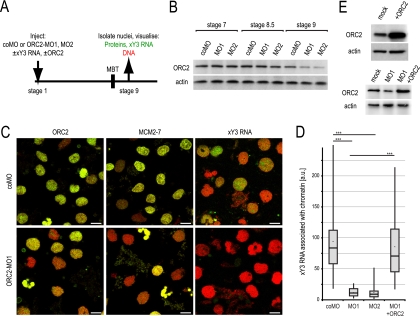Fig. 10.
ORC is required for Y RNA loading onto post-MBT chromatin. (A) Experimental design. (B) Knockdown of ORC2 expression. Xenopus laevis embryos were injected with coMO or two MOs against ORC2 protein (MO1 and MO2), lysates were prepared at the indicated stages, and ORC2 protein was investigated by Western blotting. Actin was used as a loading control. (C) Y RNA association after MBT depends on ORC. After injection of coMO or MO1, the association of ORC2, MCM2-7, and Alexa Fluor 488-conjugated xY3 RNA with chromatin was visualized by fluorescence microscopy (green signals); DNA was counterstained with propidium iodide (red signals). Bars, 10 μm. (D) Quantification of chromatin-associated xY3 RNA. For each individual nucleus, the amount of chromatin-associated Alexa Fluor 488-conjugated xY3 RNA was measured as the integrated fluorescence intensity, as detailed in Materials and Methods. Box-and-whisker plots for each distribution are shown; the median is indicated by a horizontal line, and the mean is shown by the asterisk within the boxed 25th to 75th percentile. Statistically significant differences between matched distributions are bracketed and are indicated by triple asterisks (t tests, P < 1.5 × 10−18). (E) Exogenous expression of ORC2 protein in stage 9 embryos. Stage 1 embryos were injected with a recombinant ORC2 mRNA lacking the binding site for MO1 in the absence or presence of MO1 (top and bottom panel, respectively). ORC2 protein was detected by Western blotting.

